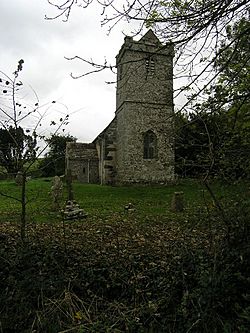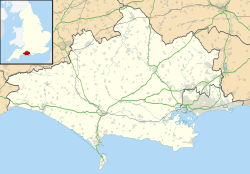Tarrant Abbey facts for kids

St Mary's Church
|
|
| Monastery information | |
|---|---|
| Full name | The abbey of St Mary and All Saints |
| Order | Cistercian |
| Established | 1186 |
| Disestablished | 1539 |
| People | |
| Founder(s) | Ralph de Kahaines |
| Important associated figures | Queen Joan, Bishop Richard Poore |
| Architecture | |
| Heritage designation | Scheduled Monument 1002715 - ruins Grade I listed building 1110840 - church |
| Designated date | 26 June 1963 |
| Site | |
| Location | Tarrant Crawford, Dorset |
| Coordinates | 50°49′53″N 2°07′20″W / 50.831431°N 2.122276°W |
Tarrant Abbey was once a special place where nuns lived and prayed. It was a Cistercian nunnery, which is a type of monastery for women, located in a village called Tarrant Crawford in Dorset, England.
Contents
The Abbey's Story
Tarrant Abbey was first started in 1186 by a person named Ralph de Kahaines. He lived nearby in Tarrant Keyneston. Later, around 1228 or 1233, it was officially re-established as a Cistercian nunnery. People believed it became the wealthiest nunnery in all of England.
Famous People Connected to Tarrant Abbey
Two very important people are linked to Tarrant Abbey's history:
- Queen Joan: She was the wife of Alexander II of Scotland and the daughter of King John of England. Queen Joan was buried in the abbey's graveyard. Legend says she was laid to rest in a golden coffin!
- Bishop Richard Poore: He was the person who oversaw the building of the famous Salisbury Cathedral. Bishop Poore was actually baptised at Tarrant Abbey. Later, in 1237, he was buried there too. He is considered the abbey's second founder.
What Remains Today
Today, the only part of Tarrant Abbey that still stands is the church of St Mary the Virgin. This church was once the local church for people living near the abbey. It was built way back in the 12th century.
The church is now a Grade I listed building, which means it's a very important historical site. The Churches Conservation Trust looks after it. The rest of the abbey's original site is a Scheduled monument. This means most of its remains are buried underground, protected for future generations.
Leaders of Tarrant Abbey
Here are some of the women who led Tarrant Abbey as Abbesses over the centuries:
- Claricia, chosen around 1228
- Emelina
- Maud, mentioned in 1240
- Isolda, mentioned in 1280
- Elena, chosen in 1298
- Anne, mentioned in 1351
- Clemence de Cernyngton, mentioned in 1377
- Joan, mentioned in 1402
- Avice, mentioned in 1404
- Edith Coker, who passed away in 1535
- Margaret Lynde (her role is not fully clear)
- Margaret Russell, chosen in 1535. She was the last Abbess and gave up control of the abbey to King Henry VIII in March 1539. This happened during a time called the Dissolution of the Monasteries.


